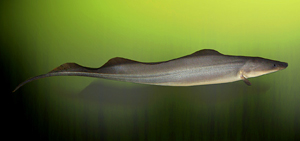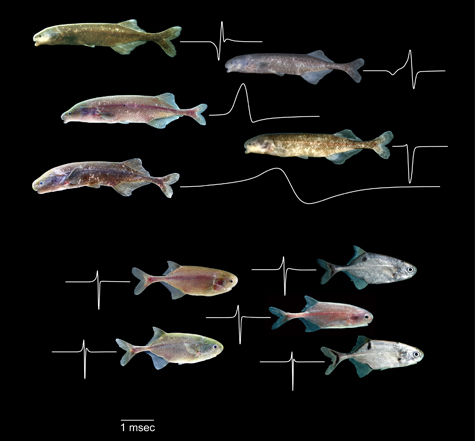


Bruce Carlson stands next to a fish tank in his lab, holding a putty colored Radio Shack amplifier connected to two wires whose insulation has been stripped. At the bottom of the tank a nondescript little fish lurks in a sawed-off section of PVC pipe.
Carlson sticks the two bare wires into the tank. Suddenly we hear a rapid-fire pop, pop, pop, pop, pop, pop. The pops, which are surprisingly loud, sound rather like the static on an old-fashioned tube radio tuned between stations.
“When there are many fish in a tank,” Carlson says, “it sounds like a frying pan.”
Carlson, PhD, assistant professor of biology in Arts & Sciences, is studying the African family of weakly electric fishes called the Mormyridae, or mormyrids.
Each fish in this family has an electric signal distinctive not only to its species, but also to its sex, dominance status and even its individual identity.
The shape of the discharge is the fish’s “face,” says Carlson. “It’s how they recognize one another.”
The sensory pathway that detects and analyzes the electric discharges in the Mormyridae had been well studied, but only in two or three species, Carlson says, and the family has more than 200. Given its diversity, Carlson asked whether changes in electrical communication might have influenced rates of speciation.
Three anatomical advances underlie the ability to send and receive diverse electrical signals: cells able to produce different discharges, a global distribution of the sensors that detect the discharges’ shape, and a more complex signal-processing area of the brain to analyze them.
In 2008 the National Science Foundation awarded Carlson a grant to travel to Gabon (where many mormyrid species are found) to study the mormyrid brain, and how brain anatomy maps onto the evolutionary tree of the fishes.
His team found that changes in brain anatomy and the resulting ability to fully exploit electric signal space did indeed lead to rapid speciation, a result published in the April 29 issue of Science.
The electric organ
Each pop is one discharge of an electric organ located at the base of a fish’s tail. The organs consist of stacks of disk-like cells called electrocytes, “pretty much like watch batteries in series,” Carlson says.
How are different discharges generated?
It has to do with something called stalk morphology.
Small stalklets arise from each electrocyte, and these stalklets fuse to form a single large stalk that receives input from the spinal cord, which fires the electrocytes.
The stalkets are not uniform but instead differ from species to species. They may arise on the back or front of the electrocytes, they may or may not penetrate the electrocytes and if they do, they may penetrate them once, twice. Some electrocytes have a mix, with some stalklets that penetrate and others that do not.
“The really nice thing is that the morphology of the stalk completely predicts the signal the electrocytes generate. If you look at the anatomy of an electrocyte, you know what kind of electric signal the fish produces,” Carlson says.
The electrocytes all fire action potentials simultaneously, and so their tiny action potentials sum to produce a discharge that is typically about a few volts.
“These signals don’t propagate as electromagnetic waves,” Carlson explains. “Instead they exist as an electrostatic field, just like you’d get by sticking a battery in the water.
“That’s why these fish are so good at recognizing pulses with different shapes,” he says. Waves are distorted during transmission, so that their fine temporal structure is smeared.
“The discharges are not distorted. They get weaker with distance, but their temporal structure stays the same. That’s one reason mormyrids evolved to be exquisitely sensitive to small timing differences in electric signals,” Carlson explains.
Detecting the pulse
Weakly electric fish have several types of electroreceptors but the ones important for communication are called knollenorgans, from the German word “Knolle,” or tuber, because they consist of bulbous cells buried just under the fish’s skin.
The knollenorgans respond to a voltage rise, firing a time-locked spike in response to outside positive-going voltage changes.
The knollenorgans on one side of a fish’s body respond to the start of a discharge and those on the opposite side respond to the end of a discharge. This lets a fish recognize a species-specific discharge by comparing the intervals between spikes coming from opposite sides of its body.
The spike time comparison occurs within the central nervous system, in a part of the brain called the extero-lateral nucleus, or EL.
Signal processing
“When we began our work, the ‘standard anatomy’ for the mormyrid brain — what you’d find if you looked in a textbook — was a two-part EL, with separate nuclei, or clumps of cells, in the anterior and posterior portions,” Carlson says.
“We collected lots of brains in Gabon, and two collaborators, Saad Hasan, a former undergraduate at Washington University, who is now a medical student at Cornell, and Derek Miller, who is an undergraduate at Washington University, did all the histology on the brains.
“In addition to the standard anatomy, we were amazed to see another anatomy, where the EL is substantially smaller and not split into two portions.
“All the fish we looked at either had the large EL that was divided into anterior and posterior halves, or they had the small undifferentiated EL,” Carlson says.

Wikmedia Commons Wiki-Harfus; modified by Wildfeuer
Gymarchus niloticus, the closest related species that is not part of the Mormyridae family, solved the riddle of the ancestral history of the fishes. It has the simpler form of EL, which tipped the evidence in favor of the scenario where the complex brain evolved twice.
Working with collaborator Matthew Arnegard, PhD, a postdoctoral fellow at the Fred Hutchinson Cancer Research Center in Seattle, Wash., the scientists mapped the brain anatomy onto a phylogenetic tree (an evolutionary tree based on the similarity of DNA sequences), and they could see that there were two equally parsimonious ways to reconstruct the fishes’ evolutionary history.
Either the complex brain was ancestral and the simpler brain evolved twice or the simpler brain was ancestral and the complex brain arose twice. To solve this riddle, they did what evolutionary biologists do, which is look at the “next outgroup member,” the closest related fish that’s not part of the Mormyridae family.
This fish has an area in the midbrain that is similar to a small, undifferentiated EL. This suggested the EL brain was probably the ancestral brain, and the more complex divided ELa/ELp evolved twice, once within the subfamily Mormyrinae and once within the subfamily Petrocephalinae.
Which came first, the sensors or the brain?
Previous work had also identified two patterns of knollenorgan organization: receptors sprinkled all over the body, or clusters of receptors on the head.
Analysis performed by a former postdoctoral fellow in the Carlson lab, Michael Hollman, PhD, revealed that the more complex brain is universally associated with a broad distribution of knollenorgans, Carlson says.
The way the fish tell one signal from another is by monitoring the responses of sensors located all across the body surface. The bigger your array of receptors, the bigger the space you’re sampling, and the better you should be at signal analysis.
But which came first, the receptors or the brain? Carlson says he can’t be sure, but he suspects the sensors were first, in part because of an oddball species called Petrocephalus zakoni that has a broad distribution of knollenorgans but a small EL.
“That tells us the broad distribution of receptors can evolve independently of changes in the brain,” he says.
Did fancy anatomy lead to rapid diversification?
If a communication system is to promote species diversity it must have both the capacity to create new signals (flexible stalk morphology) and the ability to distinguish those new signals from other signals (the broad distribution of knollenorgans and the complex brain).(See sidebars “How are different discharges generated?” and “Which came first, the sensors or the brain?”)
“The only fish that have all three is a group of mormyrids we ended up calling Clade A for simplicity’s sake,” Carlson says.
To test the importance of these traits on signal divergence we analyzed the discharges of fish collected in two locales: the Ivindo River of Gabon, home to the largest known assemblage of the subfamily Mormyrinae; and Odzala National Park in the Republic of the Congo, home to the largest known assemblage of the subfamily Petrocephalinae.
“Statistical analysis showed us that the rate of signal divergence in Clade A was 10 times higher than among other fish within the Mormyridae,” Carlson says. Further analysis by collaborator Luke Harmon, PhD, assistant professor of biology at the University of Idaho, revealed that the number of species in clade A has been increasing three to five times faster than the number of species in other mormyrid lineages.

Sebastien Lavoue, Carl Hopkins, John Sullivan and Matthew Arnegard.
In the top group of fish, discharges have changed quickly, resulting in dramatically different pulses among closely related species. In the bottom group of fish, all of the species have similar pulses. The difference arises because the top group has the anatomical features needed to exploit the signal space — such as the anatomy needed to make different pulses and the sensory and analytical ability to perceive small differences in pulse shape.
In other words, the fancier the fishs’ communication kit, the more likely it was to come up with new electric discharges and new species that identified one another by those discharges.
Putting it to the test
It all worked out statistically and logically, but was it what the fish actually experienced?
“After all,” says Carlson, “this sensory world is totally foreign to us. I’ve worked with these fish a long time, so I can tell a few of the discharges apart by ear. But for the most part, I need an oscilloscope to see the differences.
Can the Clade A fish tell the difference between discharges? To test them, Carlson ran behavioral playback experiments on fish caught in Gabon.
“A fish would be going pop, pop, pop and we’d pulse it. Depending on the fish, it would either discharge more rapidly, brrrrrrrrr, or stop discharging altogether.
“But if we repeated the stimulus again and again the fish would stop responding. Once it stopped responding, we hit it with a phase-shifted version of the same pulse. If the fish could tell the difference, the discharge rate or pause duration would increase. If it couldn’t tell the difference, there would be no change.
The experiments showed that mormyrid fish in Clade A were able to distinguish among pulses, but other mormyrids (those with the EL brain) were not.
Did the evolution of a fancy signal-processing brain drive speciation in the Mormyridae? “It’s always difficult with evolutionary studies to say that any one trait is the cause or the trigger for another,” Carlson says. “But in this case we were able to show that the complex signal-processing brain evolved before a burst of speciation, that signal variation was higher among fishes with that brain, and that these fishes could distinguish among subtly different pulses, whereas others could not.
“Together it adds up to a strong case for brain evolution triggering increased diversification.”